Latest Gear Live Videos
Robert Kirkman ‘Impressed’ With AMC

Posted by Robin Paulson Categories: Television, Image Comics,
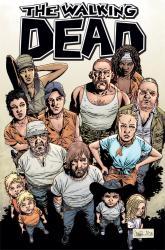 Just days after sealing the deal to The Walking Dead series, the comic book’s creator Robert Kirkman finally has a few words to say:
Just days after sealing the deal to The Walking Dead series, the comic book’s creator Robert Kirkman finally has a few words to say:
“I’m a huge fan of Frank Darabont’s body of work and AMC has impressed me to no end with Breaking Bad and Mad Men. I couldn’t be happier with The Walking Dead ending up here.”
Darabont will serve as the executive producer of the show, in addition to writing and directing duties. Image reports that “the plan is to keep the show extremely faithful to the Kirkman and Adlard’s comic book series,” which is why Kirkman had been so keen as to whom he was going to give up the rights to.
Read More  | Image Comics
| Image Comics
Advertisement
Marvel Comics Review: Ultimate Comics Spider-Man #1

Posted by David Torres Categories: Reviews, Marvel Comics,
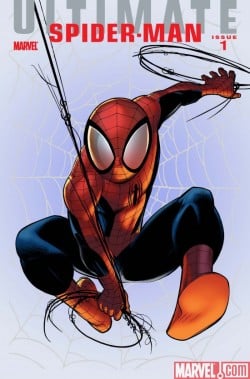
Rating: ****
Marvel’s Ultimate line of comic books began in the year 2000. It was an attempt to get new and young readers on board without them having to jump in and figure out the years of confusing continuity that’s existed before. I wasn’t collecting comics at the time when issue one of Ultimate Spider-Man came out, but I decided to pick up the first few issues. I thought it was okay. In my opinion, I think Ultimate Spider-Man really took off after the first story arc. The comic lasted for over one hundred issues and there were some moments where I lost interest in the book. I think I stopped collecting around the time Ultimate Moon Knight showed up. However, I got back into the title when writer Brian Michael Bendis introduced his own take on the Clone Saga for the title. I don’t know what it is about clones and Spider-Man that makes me go crazy. The Clone Saga got me to pick up Ultimate Spider-Man again and now it’s done it again with the regular Spider-Man book.
After the Ultimate Clone Saga ended, I dropped the book and haven’t read it since. With Ultimatum wrecking havoc in the Ultimate Universe, Marvel decided to cancel all of their Ultimate books and relaunch two of them with new number one issues. So Ultimate Spider-Man is now Ultimate Comics Spider-Man and The Ultimates is now the Ultimate Comics Avengers. So does Bendis deliver the goods once again with this new Ultimate Spidey title? You betcha!
Click to continue reading Marvel Comics Review: Ultimate Comics Spider-Man #1
Frank Darabont Sealing ‘The Walking Dead’ Deal

Posted by Robin Paulson Categories: Television, Image Comics,

For years, The Walking Dead creator Robert Kirkman has waited patiently for the perfect opportunity to pass on his precious to a director. That director is Frank Darabont.
Instead of harnessing the beloved comic books into a movie, The Green Mile director is taking the undead to the small screen with AMC.
Click to continue reading Frank Darabont Sealing ‘The Walking Dead’ Deal
Read More  | Variety
| Variety
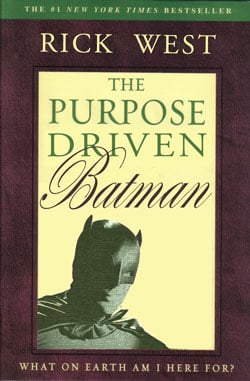
This is just too funny. The novelty book mirrors Rick Warren’s Purpose Driven Life forty-day outline for understanding Batman’s purpose in life. Rather than trying to say something clever about it, I decided to post chapter excerpts from the book. So, here they are:
Day 1: It All Starts With Batman
It’s not about you, it’s about Batman.
Or rather it’s about thinking you’re Batman. When you believe in a symbol, you become greater than what you actually are. As Batman said, “As a man I’m flesh and blood I can be ignored I can be destroyed but as a symbol, as a symbol I can be incorruptible, I can be everlasting.” Or to quote Descartes, “I think I’m batman, there I am Batman”.
For long years, Bruce Wayne traversed the globe looking for his purpose, coming up empty handed. It wasn’t until he believed in something bigger than himself, that his life changed from being driven, to purpose driven…
Day 11: Becoming Batman
You’re journey to becoming Batman, begins by arming yourself with knowledge you will need, at a later time, to escape from inescapable situations. As Batman says, “Fore-warned is fore-armed” and “An opportunity well taken is always a weapon of advantage.”
Remember that with all the technology available to you, it will not always be able to save you. As the caped crusader once told his sidekick, “I’m afraid we’re not going to get much help from the Batcomputer, Robin. It can’t go back to prehistoric times.” More often than not, Batman relies on his superior education and training to see him through various villainous snafus.
In following Batman’s example, learn about the dangers of common every day items; as Batman said, “Bartender, a bit of advice. Always inspect a jukebox carefully. These machines can be deadly.” Batman maintains this frame of mind, because “He who knows how to fear, Robin, knows how to proceed with safety.’ A translation from the Latin.”...
Day 19: Cultivating Useless Knowledge That Will Later Be Useful
As Batman, you must not only be well versed in common knowledge, but also in un-common knowledge. This includes learning ancient culture’s uncommon dates and times, such as, “Oda wabba simba”, which is, “Six o’clock in our nomenclature. In the 14th dynasty, the hour of the hyena. The time when ancient Egyptian super-criminals invariably struck!”
Memorization of an umbrella gun’s mechanical functions and operations can also be handy, when needed to thwart villains. This deeper understanding of unusual weaponry physics, could save your life, as it has saved Batman’s many a time. In one instance, he explained his foreknowledge to Robin, saying, “I observed the recoil of that umbrella gun. Obviously, its angular momentum was inadequate for the mass of a real bullet.” ...
Day 28: Understanding Batman
Batman lives his life by a moral code of uprightness and persistent pursuit of truth and justice in all of his acts. He put it best, when he says, “In the end, veracity and rectitude always triumph.” He places emphasis on being early, rather than late, saying, “Better three hours too soon than a minute too late.” Always remembering there was “No time to tarry, lest we forget, lives are at stake.”
In this way, Batman lives his life consistently ahead of the curve, prepared for whatever life may throw at him. In understanding how Batman prepares for life, we understand how he lives life. Let us not forget, “He who hath life hath time. A proverb worth remembering.”...
DC Comics Review: Justice League: Cry for Freedom #2

Posted by David Torres Categories: Reviews, DC Comics,
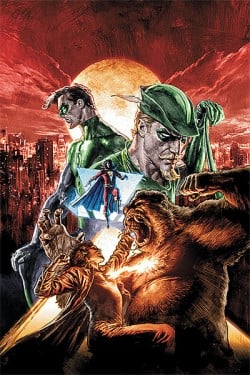
Rating: ***
When the original concept of a Justice League book written by James Robinson first surfaced, I became very interested. After a long delay, the series finally began last month. It was originally supposed to be an on-going series, but it’s now a mini-series which lays the groundwork for when James Robinson takes over the current on-going Justice League book. To review this issue, I have to give a little background on the last one. Hal Jordan is tired. He’s tired of seeing his friends die at the hands of super-villains. He’s tired of reacting to their criminal acts and wants to act before they do. He wants to go on the offense and not stay on defense. He wants justice! The rest of the League think Hal is acting irrationally - all except Green Arrow.
Other heroes in the DC Universe share Hal’s desire for justice. Heroes like the alien Starman Mikaal Tomas who sees his lover Tony die at the hands of super-villains; Congorilla who sees his gorilla friends and the hero Freedom Beast die at the hands of hunters. Is there a connection?
We shift over to issue two where Green Lantern and Green Arrow are in Gotham City and they meet up with Jason Bard. For those who are not aware of Jason Bard, he’s a private investigator who worked with Batman. Bard hears that Green Lantern and Green Arrow are out looking for some super-villains. He tells them that Prometheus and a bunch of other villains are in town waiting for instruction from someone. Hal and Ollie leave Bard and go after the bad guys.
Click to continue reading DC Comics Review: Justice League: Cry for Freedom #2
The Secret to Publishing Your Comic With Dark Horse

Posted by Kris Madden Categories: Editorials, Reviews, Dark Horse Comics,
“How do I get my great comic book idea published?” I’m glad you asked because Dark Horse is giving away the answer. No need to pickup a thick copy of “Writer’s Market 2009” to find out what DH is looking for from their creative talent. Senior editor, Randy Stradley, offers specific advice on breaking into the comic book industry. A goldmine of information to aid up-and-coming artists, Stradley offers details on new talent turn-around times and necessities for artist portfolios. A great resource for unpublished and up-and-coming comic books artists.
For More on Randy Stradley:
- A candid interview on his history with Dark Horse and what his plans for the future are at Digital City
- More tips on getting published in a Horsepower post.
- His process as senior editor and work with Dark Horse in CBR’s interview with Randy from February 2009,
For more on submitting work to Dark Horse, here is Dark Horse’s submission guidelines and sample script for artists.
Closed-Captioning for the Hearing Impaired per VideoJug:
How can an artist submit his work to you?
We have an open-submission policy. The people can send us stuff through the mail anytime. It tends to pile up for a while. We get a chance to look through it and we’ll whittle the pile down to nothing. It then builds up again. Here at the shows, people sign up ahead of time and it’s generally first-come, first-serve. For years we’ve tried to figure out a way to triage the line so that we tell the people who are ready, yes, get in line. For the people who aren’t, you’re not ready yet. You don’t need to show your work to an editor. It seems like, in recent years, that showing your work to the editor has become the “in” thing that you do. It’s just what you do. They don’t even know why they’re showing their work to an editor because I’m not an artist. I can’t really tell them how to draw better, or what techniques they should use. My job is to find people who can be given an assignment and be expected to pull it off.
What is the ideal artist portfolio?
The ideal artist portfolio is probably five to ten pages of consecutive story telling. Something that starts with a quiet scene and moves to an action scene. It includes everyday people in street clothes, buildings, cars, furniture, the stuff that the readers see every day. I always tell the artists being able to draw all the mundane stuff well is the most important part of seducing your readers into believing what they are looking at. So then when the monsters show up and the superheroes show up they are ready to except things. You have lured them in with this sort of real world that they can believe in, so they suspend their disbelief and the fantastic stuff goes down easy.
Do you prefer reviewing original or photocopies?
I am happy to look at copies, as long as they are good copies. I don’t need to see the full size originals. Yeah, it’s not a big deal.
What is the best advice for an artist submission?
Try before you show your portfolio, try to get a realistic assessment of your skill level and you do that by showing your work to somebody other than your family and friends who are all going to say, “Oh yeah, that’s great.” They’re not really going to be honest with you. So if you can find another comic artist to show your work to or strangers sometime or a teacher or something like that. Find out if you’re ready to be showing your work to try and get a professional job. Then when you do show your work, treat it like it’s a job interview. Be serious about it, come prepared. Don’t come with a bunch of excuses like well I didn’t have time to finish these pages, well yeah because COMICON only happens once a year so it totally took you by surprise didn’t it? Those things don’t fly. I want to see you show up as if you were doing a job interview.
Is having contact information on my work important?
It should be on everything that they leave with me. I’ve had it happen in the past where somebody’s given me great samples and I get back to the office and I realise they don’t have their name, phone number, email address or anything on the pages. Therefore, I have no way to know who that person is and no way to contact them. I’ve had great samples in the past for somebody who didn’t get a job because I didn’t know who they were.
Do you try to match the artist’s work you see to the stories you already have?
No, but I’m greedy. I think about the books I’m editing and what I have coming up and I think, “Oh, this guy would be good for that,” and “Oh yeah, I need an artist for this story”. Theoretically, I’m here being the eyes for all of the artists or all of the editors at Dark Horse, but I always think of myself first.
Do you look for a specific style of work?
You know for main stream comics, personally I edit a lot of Star Wars books. So I am looking for something like an artist who can handle likenesses, who can handle all the details of the hardware and everything but it can also be stylized and we have room for that. But generally if somebody is not drawing sort of, at least quasi realistically, probably their best bet is to either write their own story or attach themselves with a writer. And come up with a story that suits their style. And I am not saying find a Star Wars story that suits their style, but find you know, the kind of story they want to tell. That is how Dark Horse got started was with artists and writers who had stories of their own that they wanted to tell. We did not have any established characters when we started. So we could not say, oh write me this kind of story or draw this. We went with what they had created. The thing that separated Dark Horse at the beginning was that we allowed them to regain control of their own creations. Whereas if they had brought those creations to other companies, they would have had to sign away the rights to them.
Should I submit fully inked or colored artwork?
I would rather see just the pencils, or if they are going to show me ink work, have photocopies of the pencils, because not every artist is their own best inker. In fact, most of them aren’t, and with the way scanning technology has improved in recent years, we actually scan a lot of books directly from the pencils, and are able to reproduce them. In the old days when we had to photograph things, you just couldn’t do that. If it wasn’t dark enough, you needed to have the books inked. But nowadays, I only have one inker and I have got all the other books that are inter-shot directly from the pencils.
What happens if you like my artwork?
That’s when the challenge starts because if I say “you’re hired”, you have a month or forty days to turn around a 22 page story. Some are going to drop dead in terror, because they’re excited about it, at the time they think that’s what they wanted to do, but when it comes right down to it, drawing comics is a lot of work. And, I’ve had a number of occasions where somebody new has drawn one issue and that’s it. They decided “I can’t draw comics any more - it’s to much work.” And you really have to want to do it, especially we’ve had a lot of people who do movie story boards and they work in the entertainment industry and they’re in love with the idea of doing comics. So they do one issue and they are like, “No. I get paid a lot more to do story boards, I’ll stick with that.”
Does being a comic book artist pay well?
Paid rates are all over the board now. There are some people who make pretty good money. I had one agent telling me that, “Hey we’ve got artists who they’ll pencil, ink, letter and color an entire issue for $2500”. So you break that down, that’s a little over a hundred dollars a page for a lot of work. We try to pay better than that. But things aren’t as good as they were in the early nineties during the boom time, when there were artists literally making fortunes, because so many books were being sold and they were making so much money. But comics don’t sell that well anymore.
WEEKEND READING: Chris Ryall, Twilight, Robert Maguire, Trevor Von Eeden and Jim Shooter

Posted by Tom Mason Categories: Editorials,

Lots of great stuff all over the internets this past week. Chris Ryall at IDW gives a chat, Jim Shooter plays 20 questions with the fans, young women try to dress as sexy super-heroines, and Trevor Von Eeden is just a really great artist whose work is fun to look at. Let’s roll it out:
CHRIS RYALL’S BAT BOY: Over at Bookgasm, one of my regular stops, Joshua Jabcuga sits down with Chris Ryall at IDW to chat about Donald Westlake, Stephanie Meyer’s Twilight and the upcoming Weekly World News Universe of Bat Boy and Ed Anger. Even better, Chris has love for the Twilight fans who ravaged Comic Con International that other industry types should embrace: “I love anything that brings in a wider audience, and ideally, at a show like this, that audience who might only be drawn there by Twilight will then see something else that catches their eye and gets them into comics. I don’t know if that happened this year to any big degree, but the exposure can’t hurt. I certainly see it as a good thing.” More at the link; it’s worth reading the whole thing.
OF COSTUMES AND COSPLAYERS: You know you love it when too many women dress up as Slave Leia from Return of the Jedi. The boys – oh so obviously the boys – at Cinematical have a fun slideshow of some of the costumed women from this year’s Comic Con International. I’d write more, but I know you’ve already clicked the link.
Top 3 Animated YouTube Tributes to “Bohemian Rhapsody”

Posted by Kris Madden Categories: Editorials, Reviews,
Preface
While all of these videos are amateur in their construction, all three have a hilariously innovative take of Queen’s classic track. There are other “Bohemian Rhapsody” tribute videos online, but in my opinion these are the cream of the crop incorporating animation into their video. If you think another video should have made the list, post a comment here.
1. GOLD: “Bo He-Man Rhapsody”
2. SILVER: “Bohemian Rat-sody”
Clocking in under 40 seconds, I can’t help but laugh every time I watch this video. I’m a sucker for animated rodents singing pop songs in a high-pitched chorus. If the animator had developed this further for a longer portion of the song, they could have taken the number 1 spot.3. BRONZE: “Bohemian Rhapsody Animation”
The video has some moments of unique artistic vision. Even though some of its figures are simplified in their shape, the overall theme and use of text throughout increase strength to Queen’s song into an over the top anthem for escape. However, it loses marks for ending abruptly, not using more of the song, and not having a clever title.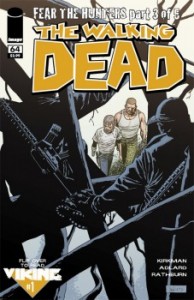 Image Comics released a five-page preview (which can be seen after the jump) of Robert Kirkman’s upcoming The Walking Dead #64.
Image Comics released a five-page preview (which can be seen after the jump) of Robert Kirkman’s upcoming The Walking Dead #64.
The issue, which hits your local comic book store next Wednesday, is the third part of the five-issue “Fear the Hunters” arc. Last issue left us with a chilling image of a helpless Dale surrounded by the merciless hunters.
From the looks of the preview, Robert Kirkman masterfully delivers readers the disturbing dialogue perfectly in tune with Charlie Adlard’s gruesome images. While I have lamented about my dislike of the last couple issues, the preview alone has satisfied my insatiable craving for a nice twist.
Click to continue reading Preview: The Walking Dead #64
Read More  | Comic Book Resources
| Comic Book Resources
Marvel Comics Review: Marvels Project #1

Posted by David Torres Categories: Reviews, Marvel Comics,
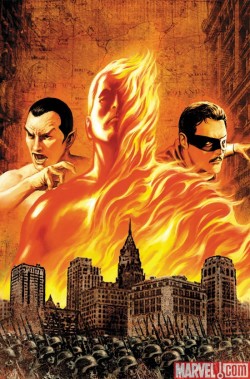
Rating: *** 1/2*
I forget where I first read the preview for the mini-seriesThe Marvels Project. I heard about this series prior to reading the preview and I didn’t really have an interest in picking it up. It sounded cool, but with limited funds, I decided I was going to pass on this one. However, after reading the preview, I was hooked and committed to picking up the series.
Our story begins in 1938 at the dawn of the Marvel Universe. An old man is dying in a hospital bed and tells a doctor about the coming age of the super heroes. The doctor doesn’t believe him of course and the old man dies shortly after telling his story. He does however leave the doctor a gift. The gift is a wooden box that contains a pair of six shooters and it is then the doctor realizes that the man who died - Matthew Hawk - was the famed Two-Gun Kid. Now for those of you who don’t know, the Two-Gun kid is hero within the Marvel Universe who existed in the Old West within the Marvel Universe. He did however join the Avengers for a period after traveling through time.
The story then flashes forward a year later to FDR and the coming US involvement in World War II. We also see Namor the Submariner battling Nazis who are “fishing” for Atlanteans in order to use them for experiments. Namor is of course not too pleased about this and takes these guys on. During World War II, the super heroes that battled the Nazis consisted of Captain America, Bucky, Namor, and the Human Torch. The Torch is also introduced here as we see his origin in how he was invented and then encased in concrete as his creator Professor Phineas Horton could not control him from bursting into flames. The original Human Torch was an android and the people of the time were angry that scientists created this artificial being. To some it was a sin and against the laws of nature which was another reason why he was encased in concrete.
Click to continue reading Marvel Comics Review: Marvels Project #1










